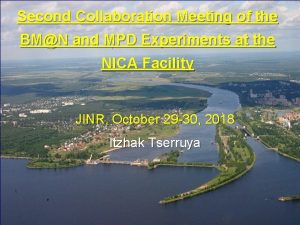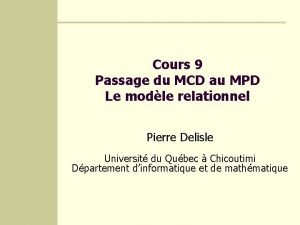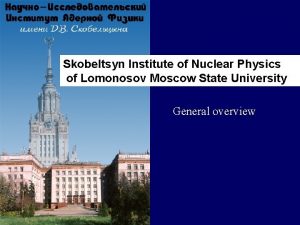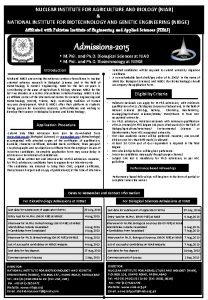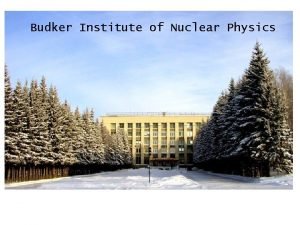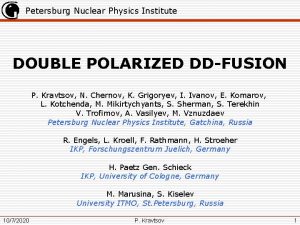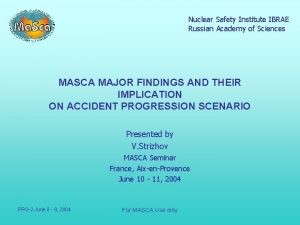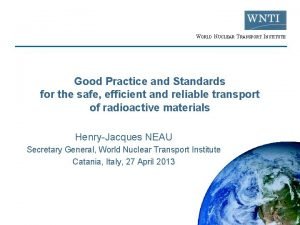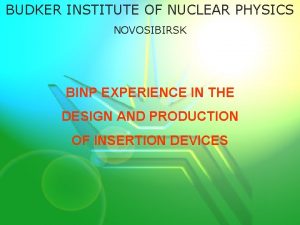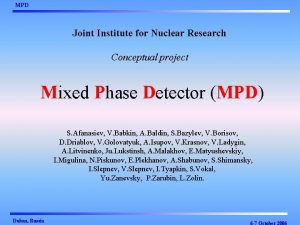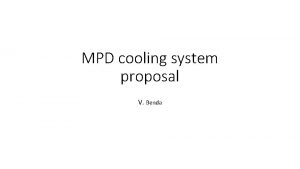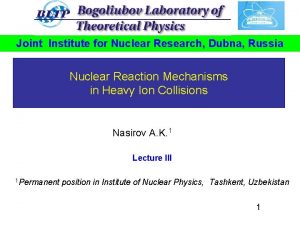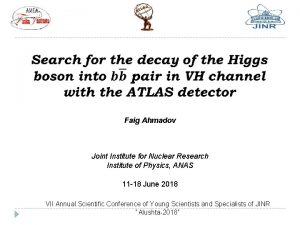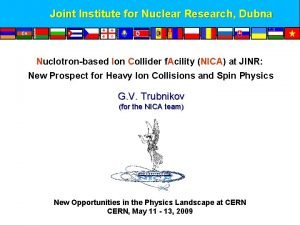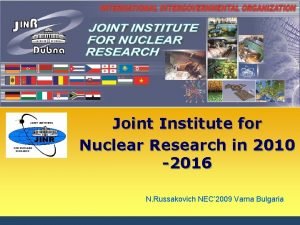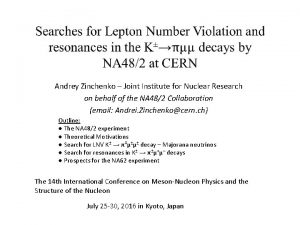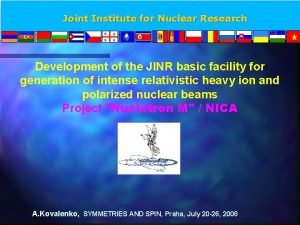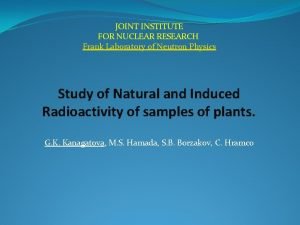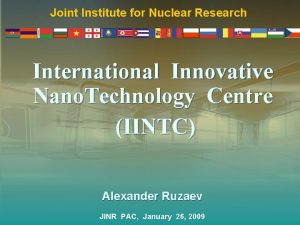MPD Joint Institute for Nuclear Research Conceptual project



















- Slides: 19

MPD Joint Institute for Nuclear Research Conceptual project Mixed Phase Detector (MPD) S. Afanasiev, V. Babkin, A. Baldin, S. Bazylev, V. Borisov, D. Driablov, V. Golovatyuk, A. Isupov, V. Krasnov, V. Ladygin, A. Litvinenko, Ju. Lukstinsh, A. Malakhov, E. Matyushevskiy, I. Migulina, N. Piskunov, E. Plekhanov, A. Shabunov, S. Shimansky, I. Slepnev, V. Slepnev, I. Tyapkin, S. Vokal, Yu. Zanevsky, P. Zarubin, L. Zolin. Dubna, Russia

MPD Experimental setup should allow to measure: - Event-by-event fluctuations. The hadron yields and momenta should be analyzed event-wise in order to search for strong fluctuations which are predicted to occur in the vicinity of the critical endpoint and when penetrating the coexistence phase (the mixed quark-hadron phase) of the first order deconfinement phase transition. In order to subtract the (dominant) contributions from resonance decays one should measure the yields of the relevant short-lived hadron resonances. - Multistrange hyperons. The yields, spectra and collective flow of (multi) strange hyperons are expected to provide information on the early and dense phase of the collision as they are produced close to threshold. Therefore, these particles are promising probes of the nuclear matter equation of state at high baryon density. - HBT correlations. Observation of short correlations of π, K, p, Λ hadrons allows one to estimate the space -time size of a system formed in nucleus-nucleus interactions. Alongside with the increase of fluctuations, the spatial size of the system is expected to be enhanced at the phase transition getting smaller near the deconfinement point due to softening the equation of state (the "softest point" effect). - Penetrating probes. Measurements of dilepton pairs permit to investigate the in-medium spectral functions of low-mass vector mesons which are expected to be noticeably modified due to effects of chiral symmetry restoration in dense and hot matter. Specific properties of the σ-meson as a chiral partner of pions, which characterizes a degree of chiral symmetry violation, may be in principle detected near the phase boundary via a particular channel of σ-decay into dileptons or correlated γγ-pairs. Above a beam energy of about 15 AGe. V also charmonium might be detectable. J/Ψ mesons are a promising probe for the deconfinement phase transition. - Open charm. D-mesons probe the early phase of the collision and are sensitive to in-medium effects due to chiral symmetry restoration. Dubna, Russia

MPD Setup overview Scheme of the MPD setup. TPC - Time Projection Chamber; SVS - Silicon Vertex tracking System; TRD - Transition Radiation Detectors; TOF - Time of Flight detectors; EC - Electromagnetic Calorimeters; LENS - magnetic focusing lens of collider Dubna, Russia

MPD Dubna, Russia

MPD Main components of proposed MPD setup: - Superconductive Magnet System (MAGNET COILS); - Vertex tracking System; - Central Arm; - Two Forward arms; Each Arm include Time Projection Chamber (TPC); Transition Radiation Detectors (TRD); Time of Flight detectors (TOF); Electromagnetic Calorimeters (EC). Dubna, Russia

MPD 6. 2 Superconductive Magnet System The superconductive magnet system is composed by two pairs of concentric coils and provides a field (1 -2 T) parallel to the beam. For the forward angle, the magnetic field is formed by iron cones and produces a radial magnetic field for the forward angle analysis. The primary physics-driven requirements for the central magnet design are: (i) No mass in the apertures of the spectrometer arms to minimize interactions and multiple scattering of particles produced in the primary collision and to minimize albedo from the magnet poles. (ii) Dense material near the collision point in the apertures of the forward arms to serve as hadron absorbers. (iii) Reasonably uniform field that could be mapped to a precision in the field integral of about 2 parts in 1000. (iv) Control over the radial field distribution to allow creation of a "zero field" region near R = 0. (v) Minimal field integral for the region R > 200 cm, the radius of the TPC. Field in the region of the photomultiplier tubes of the TOF and the Electromagnetic Calorimeter are also required to be low. (vi) The magnet must be easily moveable to allow access to detector components for commissioning, maintenance and replacement. Dubna, Russia

MPD Silicon Vertex tracking System(SVS); The vertex tracking is based on highly segmented silicon pixel and microstrip detectors at mid-rapidity, and further silicon pixel detectors in the forward direction. Three internal central layers of SVS are constructed from silicon pixel detectors and three outer layers are built from microstrip silicon detectors with a pitch from 25 to 50 mkm. They will be arranged in two half-shells and will cover approximately − 5 o< <40 o and almost 2 in azimuth. Pixel sensor technology is essential for the resolution of the high track density in heavy ion collision in the internal layer. Microstrip detectors also could be used in the more outward layers where the occupancies are less severe. The forward silicon detectors will consist of four pixel cones per side that match the geometrical acceptance Dubna, Russia

MPD Tracking System A large Time Projection Chamber (TPC) is proposed as a main tracking device for the detector at future collider. The ambitious physics program poses unprecedented requirements on the precision of the TPC. This modern experiments plan to use TPC at high charged particles multiplicities of up to 800 per event. The modern experiments are propose to work at unprecedented high multiplicities up to 8000 per unit rapidity - ALICE TPC (CERN/LHCC 2000– 001). Another example of the tracking system is the STAR TPC which is able routinely reconstructs more than 3000 tracks per one event (M. Anderson et al. , Nucl. Instr. Meth. A 499 (2003) 659). TPC operation parameters Centarl TPC - diameter = 5. 6 m - lenght = 2. 0 m Forward TPC - diameter 1 = 1. 5 m diameter 2 = 5. 0 m - lenght = 2. 0 m Drift time -=50 s Dubna, Russia

MPD The STAR TPC The STAR detector contains a large, cylindrical, Time Projection Chamber (TPC) as its primary detector element. The TPC has an active volume that extends from -1. 8 to +1. 8 units of pseudo-rapidity with full azimuthal coverage. It sits inside a large solenoidal magnet which is designed to run with a. eld between 0 and 0. 5 T. The event multiplicities excess of 3000 tracks per event. The momentum resolution is 2% at 500 Me. V/c: The two-track resolution for HBT pairs of tracks is 2. 5 cm. The d. E=dx resolution is Excellent It able to separate the pion band the proton band at momenta up to 1. 3 Ge. V/c and the resolution is 7. 5%. Dubna, Russia A L I C E TDR of the Time Projection Chamber To cover this acceptance the TPC is of cylindrical designwith an inner radius of about 80 cm, an outer radius of about 250 cm, and an overall length in the beam direction of 500 cm. Two-track resolution: a resolution in relative momentum of a few (_ 5) Me. V/c can be performed. Resolution in d. E/dx: For hadron identification a d. E/dx resolution of 8% is desirable, following the experience of NA 49. Track matching capability to ITS and TOF: Should be 85%– 95%. Electronics: At about 570 000 channels the front-end electronics

MPD Dubna, Russia

MPD Particle identification with TPC An strength of the tracker in solenoid magnetic field at MPD is a large and uniform acceptance capable to measure and to identify substantial fraction of the particles produced in heavy-ion collisions. For stable charged hadrons, the TPC provides pions and kaons (protons) identification up to pt ~ 0. 7 (1, 1) Ge. V/c by ionization energy loss (d. E/dx). A TOF system with a time resolution of <100 ps is able to identify pions and kaons (protons) up to pt ~ 1. 6 (3. 0) Ge. V/c, as demonstrated in Fig. . Combination of d. E/dx in the TPC and velocity measurements by TOF provides a strong tool for the dilepton measurements. Dubna, Russia

TRD MPD The Transition Radiation Detector (TRD) will provide, in conjunction with data from the TPC and EC detectors, sufficient electron identification to measure, in the dielectron channel, the production of light and heavy vector-meson resonances for UU collisions at the NICA, as well as allow to study the dilepton continuum. In addition, the electron identification provided by the TPC and TRD at relatively large transverse momenta (pt 1 Ge. V/c) can be used, in conjunction with the impactparameter determination of electron tracks in the ITS, to determine the overall amount of open charm and open beauty produced in the collision. With a similar technique one can also separate directly produced J y mesons. TRD system Design goals e/π discrimination of > 100 (p > 1 Ge. V/c) High rate capability up to 150 k. Hz/cm 2 Position resolution of about 200 μm. Large area ( 50 m 2, 3 layers) MWPC Dubna, Russia Straw tubes

MPD Electromagnetic Calorimeter. (EC) Lead-Scintillator Calorimeter The Pb-scintillator electromagnetic calorimeter is a shashlik type samplingcalorimeter made of alternating tiles of Pb and scintillator consisting of 1500 individual towers and covering an area of approximately 18 m 2. The basic building block is a module consisting of four (optically isolated) towers which are read out individually. The Pb. Sc calorimeter has a nominal energy resolution of 8. 1%/ E(Ge. V ) +2. 1% and an intrinsic timing resolution better than 200 ps for electromagnetic showers Dubna, Russia

MPD ZDC Dubna, Russia

MPD Table 8. 4. Schedule of MPD group II realization Dubna, Russia

MPD Dubna, Russia

MPD Summary Mixed Phase Detector (MPD) - operate at the energy of beams 2. 5 x 2. 5 Ge. V/u; - work at the luminosity of the heavy ion beams up to 1027 cm-2 s-1 for U+U; - has practically 4 geometry; - has minimum of passive matter in the detector volume; - allow to measure high multiplicity events, up to 1000 particles/event; - to separate e, , K, p particles in range 200<P<2000 Me. V/c; - to measure lepton-pairs and -pairs; This setup can be use for solution of fundamental scientific questions : • the nuclear matter equation-of-state at high baryonic densities; • the in-medium properties of hadrons; • space-time evolution of nuclear interaction; • the phase transitions; • the QCD critical endpoint; + Polarization studies at new facility Dubna, Russia

MPD Thanks for attention! Dubna, Russia

MPD Dubna, Russia
 Mpd collaboration meeting
Mpd collaboration meeting Mpd base de données
Mpd base de données Lesson 15 nuclear quest nuclear reactions
Lesson 15 nuclear quest nuclear reactions Fisión nuclear vs fision nuclear
Fisión nuclear vs fision nuclear Skobeltsyn institute of nuclear physics
Skobeltsyn institute of nuclear physics Nuclear institute for agriculture and biology
Nuclear institute for agriculture and biology Budker
Budker Petersburg nuclear physics institute
Petersburg nuclear physics institute Nuclear safety institute of the russian academy of sciences
Nuclear safety institute of the russian academy of sciences Benefits of joining the institute
Benefits of joining the institute World nuclear transport institute
World nuclear transport institute Budker
Budker Conclusion on topic family
Conclusion on topic family Lamb quality grades
Lamb quality grades Costotransverse joint
Costotransverse joint Non-permanent joint คือ
Non-permanent joint คือ Memorandum joint venture
Memorandum joint venture Lamb carcass grading
Lamb carcass grading Ellipsoid joint examples
Ellipsoid joint examples Fspos vägledning för kontinuitetshantering
Fspos vägledning för kontinuitetshantering
